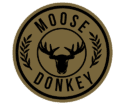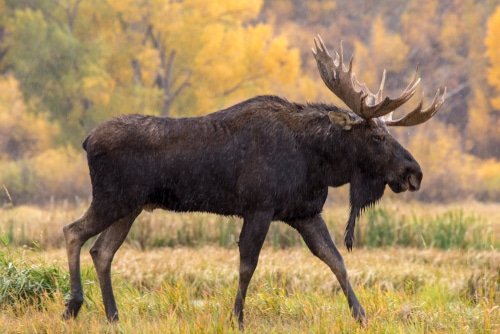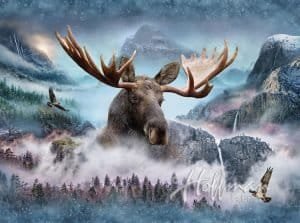Ah, the majestic moose! Known for its impressive antlers and towering presence, this incredible creature has captured the imagination of nature enthusiasts worldwide. But have you ever wondered where these magnificent beasts call home? Well, my friend, that’s what we’re here to explore – the enchanting realm known as moose habitat.
A Peek into Moose Habitat Requirements
To truly understand and appreciate moose habitat, it’s crucial to comprehend what makes this environment so desirable for our antlered friends. First and foremost, moose are creatures of the forest.
They thrive in areas abundant with lush vegetation that provides an array of tasty treats for their voracious appetites. From tender willow branches to delectable aquatic plants, moose are discerning connoisseurs regarding their menu.
The Conservation Connection: Why Understanding Moose Habitat Matters
Now, you might be wondering why anyone should bother delving into the intricacies of moose habitat. Well, my curious companion, understanding where these gentle giants dwell is vital for conservation efforts.
As human activities continue to encroach upon natural landscapes, it becomes increasingly crucial to safeguard the habitats that sustain our wildlife populations. By comprehending the specific requirements of moose habitats and working towards their preservation, we can ensure that future generations will have the privilege of witnessing these magnificent animals in all their glory.
So gather ’round as we embark on a journey into the fascinating world of moose habitat. Let us uncover the secrets within their geographical range and discover how these majestic creatures thrive amidst Mother Nature’s embrace.
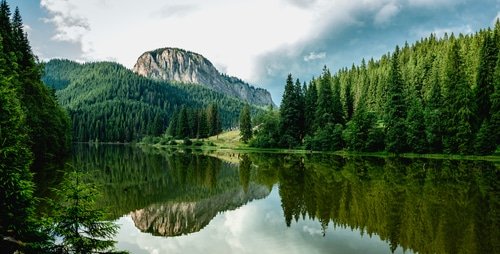
General Characteristics of Moose Habitat
The Majestic Wanderers: Moose Geographical Range
When it comes to moose, they are not confined to a particular neighborhood; these magnificent creatures have quite an expansive geographical range. Moose can be found in various regions across the Northern Hemisphere, from North America to Europe and Asia. In North America, their domain stretches from Alaska down to parts of the United States, including states like Maine, Minnesota, and Wyoming.
Meanwhile, in Europe and Asia, moose roam through boreal forests in countries such as Sweden, Norway, Russia, and Canada. Their ability to adapt to various habitats makes them true wilderness wanderers.
A Habitat Tapestry: Preferred Moose Habitat Types
Moose have a discerning taste when it comes to choosing their habitat. They favor diverse landscapes that provide an assortment of resources for their survival. Forests serve as prime real estate for moose populations; they find solace in the dense cover provided by conifers like spruce and fir trees.
Wetlands also hold great allure for moose due to their abundant supply of water-loving plants like cattails and sedges that make up a large portion of their diet. Additionally, shrublands offer an enticing buffet for these herbivorous giants, with shrubs like willows and birch providing nourishment at every turn.
It’s this tapestry-like combination of forests, wetlands, and shrublands that creates an ideal mosaic for moose natural habitat. With each stride through its vast geographical range and preference for specific habitats scattered across diverse landscapes, moose are truly remarkable beings thriving amidst nature’s intricate design.
Climate and Weather Influence on Moose Habitat
Impact of temperature, precipitation, and snow depth on moose survival
When it comes to surviving in the wild, moose are no strangers to the whims of Mother Nature. The climate and weather conditions have a profound impact on their ability to thrive in their natural habitat.
Temperature plays a vital role in regulating moose metabolism and energy expenditure. In hot summer, moose seek out cooler areas, such as shaded forests or bodies of water, to avoid overheating.
Conversely, during frigid winters, they rely on their thick fur coats and a layer of insulating fat to navigate the bone-chilling temperatures. Precipitation also has a significant influence on moose survival.
Adequate rainfall is necessary for lush vegetation growth, providing a vital food source for these majestic creatures. Droughts can lead to scarcity in food supply, forcing moose to travel longer distances in search of sustenance.
One of the most defining weather factors for moose habitat is snow depth. In regions that experience heavy snowfall during winter months, like the northern reaches of North America or Scandinavia, deep snow can pose challenges for these large animals.
High snow levels make it difficult for them to move around freely and access food sources buried beneath the blanket of white. However, moose have adapted remarkably well by using their long legs as makeshift snowshoes to traverse through deep snow cover.
Seasonal variations in habitat use by moose
Like humans switch up their wardrobes depending on the season, moose adjust their habitat preferences throughout the year based on seasonal changes. During warmer months, when vegetation is abundant and easily accessible, they favor habitats with ample grazing opportunities, such as open meadows or areas near wetlands where aquatic plants flourish.
As autumn sets in and temperatures begin to drop, moose shift their focus towards areas rich in woody browse, particularly the tender branches of willow, birch, and aspen trees. These species are not only highly nutritious but also have a higher chance of remaining uncovered by snow during colder months.
By adapting their movement patterns and selecting habitats with a diverse range of vegetation types, these magnificent creatures ensure they can meet their nutritional needs throughout the changing seasons. Climate and weather conditions have a profound impact on moose habitat.
Temperature, precipitation levels, and snow depth all play crucial roles in determining the survivability and behavior of these majestic animals. Understanding these influences is essential for conservation efforts aimed at protecting moose populations and ensuring their continued existence in the wild.

Vegetation Composition in Moose Habitat
Plant Species
In the expansive moose habitat, these majestic creatures have developed a penchant for certain plant species that tickle their taste buds. Among their favorites are the graceful willows, with their slender leaves that sway gently in the wind. These willows provide a succulent feast for moose, fulfilling their cravings for fresh greens.
Another culinary delight on the menu is the birch tree, known for its delicate yet flavorful twigs and foliage. The moose’s adept browsing skills come into play as they skillfully strip the bark and leaves off these birch beauties.
Additionally, aspens are a delicious option for moose, providing them sustenance and shelter within their vast groves. Furthermore, moose also relish aquatic plants like water lilies and pondweed when they take a dip to cool off or seek tasty snacks near serene lakes and ponds.
Diverse Vegetation for Nutritional Needs
A diverse menu is not just a treat for our taste buds; it holds even in moose! The abundance of varied vegetation in their natural habitat ensures that these gentle giants receive a balanced diet of essential nutrients. Each plant species offers its unique blend of vitamins, minerals, and fibers that contribute to the overall well-being of these magnificent creatures.
For instance, willows are packed with essential nutrients like vitamin C and calcium, while birch provides carbohydrates to fuel their energy-intensive lifestyle. The consumption of different plants also helps prevent nutritional deficiencies from relying solely on one food source.
Ultimately, this diversity is crucial in maintaining healthy moose populations by ensuring they can access various nutritious options throughout their geographical range. No HTML tags should be used except for the title and subtitle headers.
Water Sources in Moose Habitat
Dependence on Freshwater Bodies
Moose, being magnificent creatures, strongly depend on freshwater bodies like lakes, rivers, and ponds within their natural habitat. These water sources are vital in sustaining their survival and overall well-being. When roaming through the expansive moose geographical range, these gentle giants seek out these aquatic havens to quench their thirst and stay hydrated.
Not only do they find solace in drinking from these shimmering pools of liquid life, but they also utilize them for other purposes, such as cooling off during scorching summers or escaping pesky bugs that seem to bug them (pun intended) relentlessly. Moose have an innate understanding of the importance of these waterbodies and ensure that they include them in their daily routine.
Role of Water Availability in Regulating Moose Distribution
Water availability plays a pivotal role in regulating the distribution patterns of moose across their expansive moose natural habitat. These majestic creatures have an uncanny ability to sniff out water sources even from great distances.
The presence or absence of reliable freshwater bodies can significantly influence where moose roam within their territories. During dry spells or droughts, when water becomes scarce, moose tend to concentrate around areas where it is still readily available.
On the other hand, during wet seasons with sufficient rainfall that leads to abundant water sources throughout their habitat, moose have more freedom to explore larger portions of their range without worrying about dehydration. It’s truly remarkable how something as simple as water can shape the whereabouts of these magnificent herbivores.
Influence on Feeding Patterns and Thermoregulation
Water availability not only affects moose distribution but also plays a crucial role in shaping their feeding patterns and thermoregulation. Freshwater bodies provide a rich source of aquatic plants, an important part of a moose’s diet. These luscious aquatic plants, such as water lilies and pondweeds, offer vital nutrients that help sustain the moose’s massive frame and keep them healthy and strong.
Moreover, waterbodies also serve as prime grazing grounds for other vegetation along their shores, attracting moose to these areas for a buffet of tasty treats. Additionally, lakes and rivers offer respite from the summer heat when moose immerse themselves in the refreshing waters or even take a leisurely swim, cooling off their bodies and reducing the risk of overheating.
Water plays an integral role in both the dietary needs and thermal comfort of these magnificent creatures. Water sources are more than just shimmering liquid oases within the expansive moose habitat; they are lifelines that regulate distribution patterns, influence feeding behavior, and provide essential thermoregulation opportunities for these majestic creatures.
Understanding the importance of freshwater bodies is crucial in conservation efforts to protect the habitat that sustains moose populations across their vast geographical range. So, let’s appreciate these sparkling gems within nature’s tapestry while recognizing their indispensable role in supporting our beloved moose companions.
Sheltering Areas within Moose Habitat
Finding Solace in Forests: The Comfort of Canopy
When seeking refuge and protection, moose have a penchant for the peaceful embrace of forested areas. These gentle giants select specific locations within their expansive habitat that provide comfort and safety.
Forests offer moose an ideal combination of shelter from harsh weather conditions, concealment from predators, and access to food sources. By instinctively seeking out forested areas as bedding sites, moose can shield themselves from the prying eyes of potential threats and find solace amidst the tranquility of dense cover.
The Ideal Sheltering Habitat: A Hidden Oasis
For a moose to consider a location as an ideal sheltering habitat, certain characteristics must be present. Dense cover is crucial for providing both visual concealment and protection against predators.
Moose are particularly fond of habitats with thick understory vegetation, such as shrubs or young trees, which offer them a sense of security while also providing ample browse for sustenance. Additionally, forested areas near water bodies are highly favored by moose since they enable easy access to freshwater sources for drinking and cooling off during hot summer days.
The Importance of Shelter during Calving Season
Sheltering habitats hold immense significance during the calving season for female moose (cows). These expectant mothers seek out secluded locations in forests where they can give birth to their calves away from prying eyes and potential danger.
The dense vegetation not only helps shield the newborns from predators but also provides essential seclusion that allows bonding between mother and calf without disturbance. The surrounding flora also serves as a natural buffet for the nursing cows to replenish their energy reserves after giving birth.
Within the vast expanse of their geographical range, moose have a natural affinity for sheltering areas within forests. The dense cover provided by these habitats offers the moose security and protection from predators while ensuring access to vital food sources.
During calving season, these sheltering areas provide solitude and safety for mother moose and newborn calves. Understanding the significance and characteristics of these sheltering habitats is essential for preserving the well-being of these iconic species in their natural habitat.
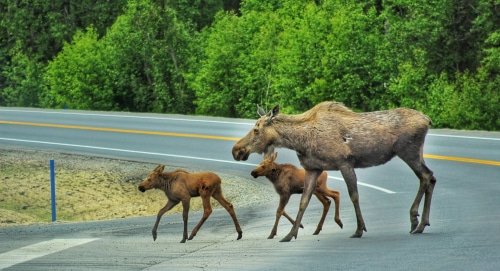
Movement Patterns within Moose Habitat
Seasonal migration patterns influenced by food availability
In the vast and untamed world of moose habitat, these majestic creatures are not confined to one place. They are known to embark on seasonal journeys in search of food to satisfy their insatiable appetites. As the seasons change and the landscape transforms, so do the moose’s movement patterns.
In areas where winters can be harsh, with heavy snowfall and limited food sources, moose will migrate to lower elevations or areas with less snow cover. This allows them to access a greater abundance of vegetation, which is crucial for their survival in these cold months.
In spring and summer, when lush greenery carpets the land, moose will venture into higher elevations or cooler areas where rich vegetation thrives. It is this continuous cycle of migration that ensures their nourishment throughout the year.
Long-distance movements during breeding season (rut)
Ah yes, love is in the air even in the wilds of moose habitat! During the breeding season, known as the rut, male moose go on a quest for romance that can take them across great distances. These lovestruck bulls will leave their usual haunts behind and embark on arduous journeys to find potential mates.
Their movements during this time can span tens or even hundreds of miles as they sniff out alluring scents left by receptive females. It’s a spectacle like no other as these massive creatures traverse forests and wade through rivers in pursuit of love.
Impact on genetic diversity through gene flow
The extensive movements undertaken by moose during both migration and breeding seasons play a vital role in maintaining genetic diversity within populations across their geographical range. As individuals from different areas come together during mating rituals, gene flow occurs – genes get mixed up like a wild dance party! This genetic exchange helps prevent inbreeding and enhances the overall health and adaptability of moose populations.
By traveling long distances, these intrepid wanderers contribute to the resilience of their kind, ensuring that future generations thrive in their natural habitat. Now, we’ve explored how moose move within their habitat, from seasonal migrations influenced by food availability to long-distance journeys during the rut.
We’ve also seen how these movements impact the genetic diversity of moose populations, ultimately contributing to their survival and continued adaptation. In the next section, let’s delve into the fascinating interactions between moose and other species that share their wild domain.
Interactions with Other Species in Moose Habitat
Role of Predators like Wolves or Bears in Shaping Moose Behavior
In the vast expanse of moose habitat, the presence of predators plays a crucial role in shaping the behavior and dynamics of moose populations. Predators such as wolves and bears are natural checks on moose populations, ensuring a healthy balance within the ecosystem. These apex predators not only influence moose behavior by instilling a constant sense of vigilance but also act as selective forces, exerting pressure on individual moose fitness.
The ever-present risk of predation shapes the spatial distribution patterns and movement strategies adopted by moose, leading them to seek shelter in dense forests or venture into open areas cautiously. This dynamic interaction between predators and their prey creates a delicate equilibrium within the intricate tapestry of nature.
Predation Risk Affecting Habitat
The predation risk faced by moose has significant implications for their habitat selection and utilization. In areas where predator densities are higher, moose often exhibit a preference for dense cover, such as thickets or tangled vegetation, which provides them with concealment against potential threats. This preference can result in alterations to vegetation composition and structure within their range, impacting other species that rely on similar habitats.
Additionally, predation risk can indirectly affect the availability and distribution of resources by influencing feeding habits. For example, heightened predation pressure may lead to shorter browsing periods or shifts in forage selection patterns as moose prioritize vigilance over feeding efficiency.
Conclusion
In exploring the interactions between species within moose habitat, it becomes apparent that nature operates with remarkable intricacy and balance. Predators like wolves and bears shape not only the behavior but also the very landscape inhabited by majestic creatures like moose. The delicate dance between predator and prey creates an ever-evolving tapestry of life, where each species plays a vital role.
Understanding these interactions is essential for effective conservation strategies aimed at preserving the natural habitat of moose and the intricate web of life it supports. By safeguarding the delicate equilibrium between predators and prey, we can ensure the resilience and sustainability of our precious ecosystems for generations to come.
